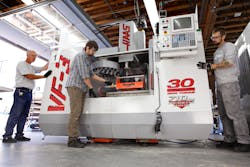How Air Casters Benefit the Manufacturing Industry
Manufacturers are always looking for ways to save time and money to gain a competitive edge. One of the simplest, yet most impactful, ways to do this in manufacturing is by using air casters.
An air caster system uses compressed air to lift and float heavy machines and tooling, even allowing them to be turned 360-deg. within their own footprint. The technology can be likened to a puck floating on an air hockey table. The equipment literally floats on a bed of compressed air and floats off the floor. It’s this low friction flotation that makes it possible for one person to effortlessly move up to over 2,200 kilos of equipment.
Downtime is the death of productivity, and when a manufacturing line is held up to remove a part or reconfigure the line, lots of money is being lost. The flexibility of movement with an air caster system is unparalleled. If a problem is found with something on the assembly line and you need to move it via a crane or forklift, operations will cease, a certified operator must be found and then the equipment must be maneuvered into place. With an air caster system, the problem piece can be removed quickly by anyone on the line. This can save hours of time and thousands of dollars.
Since air casters eliminate the need for a conveyer belt or rail system, and work alongside or sometimes replace cranes and forklifts, a plant is able to optimize its floor space. With commonly used solutions, extra space around the line is needed for maneuverability, which ultimately results in wasted space. An air caster system requires no extra space to maneuver. Equipment with air casters can be turned 360 degrees within their own footprint, optimizing the workspace and improving the productivity of the plant.
For manufacturers that make calibrated equipment, the inherent suspension of an air caster system ensures that there is no vibration when something needs to be moved.
Equipment like cranes, forklifts and anything on wheeled casters causes a lot of wear and tear on the flooring of the plant. That type of damage is eliminated with an air caster system. In some plants, like the Agie Charmilles plant in Illinois that had recently installed a million-dollar epoxy floor, the idea of having it damaged immediately by equipment was naturally not appealing.
“Prior to us going with air casters we were using forklifts to move machines in and out of this room, but we didn’t want to scratch it up using forklifts and walkies. So we needed to go with a different system. Thankfully someone recommended air casters,” said Jesus Ledesma Jr., the plant’s facilities manager.
Because most plant floors aren’t perfectly flat, moving equipment, especially on wheels and casters can be precarious. Air casters are able to compensate for small floor undulations and in the case of larger gaps, an overlay can be laid.
For employees, air caster’s biggest benefit is the safety of the system. A person’s feet can’t get stuck under the load and because nothing is ever suspended in the air the way it is with a crane or forklift, the risk is greatly reduced.
An air caster system is easy to use, requiring no formal certification to operate the system.
“How effective was air casters at solving our problem? We don’t have to use forklifts anymore. It’s especially effective because it doesn’t take many people to move machines around. It’s very safe. It’s very fast. And it doesn’t disturb other people in the room,” said Ledesma.
Despite all the benefits of an air caster system, the cost to implement it is far less expensive than the alternatives. For example, a 100T air cushion system might cost approximately 135,961 euros versus more than 900,000 euros for a crane.
With the lower cost of acquisition, coupled with the benefits and cost savings throughout the lifetime of the product, an air caster system is a smart solution for any manufacturer of heavy equipment.
